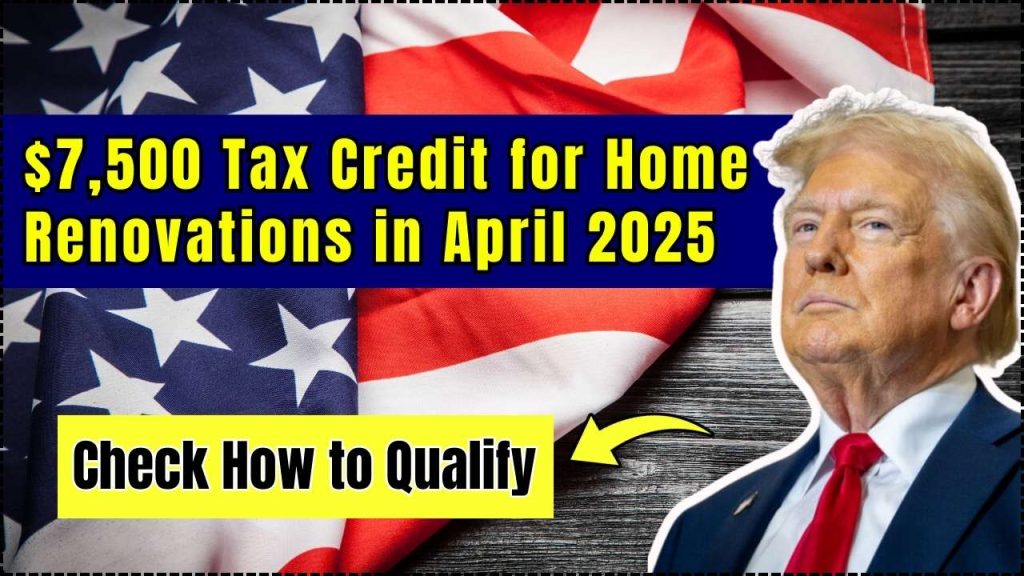Tax Credit for Home Renovations: If you’ve been thinking about upgrading your home, now might be the perfect time. The $7,500 tax credit for home renovations in April 2025 is creating buzz among homeowners across the U.S. But what exactly is this credit, who qualifies, and how can you claim it? This comprehensive guide breaks it all down in simple terms so you can take full advantage of the benefit.

While there’s no standalone $7,500 renovation credit announced by the IRS, several federal tax credits for energy-efficient home improvements and clean energy installations can combine to offer homeowners savings of $7,500 or more. This article helps you understand what’s available, how to qualify, and how to make strategic decisions that maximize your tax refund and minimize your home’s energy usage.
Tax Credit for Home Renovations
| Feature | Details |
|---|---|
| Total Possible Tax Credit | Up to $7,500 (by combining multiple credits) |
| Main Credits Covered | Energy Efficient Home Improvement Credit, Residential Clean Energy Credit |
| Credit Rate | 30% of eligible expenses |
| Eligible Renovations | Windows, doors, insulation, solar panels, heat pumps, energy audits, more |
| Max Annual Limit | $3,200 (home improvement credit) + 30% uncapped (clean energy credit) |
| Official IRS Source | IRS Energy Credits Page |
The $7,500 tax credit for home renovations in April 2025 is a powerful tool for American homeowners. By combining the Energy Efficient Home Improvement Credit with the Residential Clean Energy Credit, you can make valuable upgrades that save money, reduce your environmental impact, and increase your home’s comfort and value.
With strategic planning, proper documentation, and an understanding of how the credits work, you could walk away with thousands in tax savings this year. Whether you’re going solar or simply sealing drafty doors, Uncle Sam wants to reward your energy-conscious choices.
Understanding the Tax Credits Available
Energy Efficient Home Improvement Credit (EEHIC)
The Energy Efficient Home Improvement Credit allows homeowners to claim 30% of the cost of specific upgrades made to their primary residence in the U.S. The goal is to promote energy savings and reduce household carbon emissions, all while giving you a break on your taxes.
What qualifies?
- Exterior doors: Up to $250 per door, capped at $500 total
- Exterior windows and skylights: Up to $600
- Insulation materials and air sealing systems: Up to $1,200
- Home energy audits: Up to $150
- Efficient HVAC systems (heat pumps, biomass stoves, etc.): Up to $2,000
Annual limit: You can claim up to $1,200 annually, with a separate $2,000 cap for heat pumps and certain other systems. In a single year, this adds up to a potential $3,200.
Expert tip: You can split your home improvements across two or more tax years to reach the maximum credit over time. This is a great tactic for homeowners planning multi-phase renovations.
Residential Clean Energy Credit (RCEC)
The Residential Clean Energy Credit supports long-term energy solutions like solar, wind, and geothermal systems. Unlike EEHIC, there is no dollar limit as long as the system is installed in a qualifying property.
Eligible systems include:
- Solar electric systems (solar panels)
- Solar water heating systems
- Wind turbines
- Geothermal heat pumps
- Battery storage systems (at least 3 kilowatt-hours capacity)
This credit also covers installation and labor costs. The 30% credit applies to systems installed between now and 2032, with phased reductions beginning in 2033 (26%) and 2034 (22%). It expires in 2035 unless renewed by Congress.
Pro tip: Bundle your clean energy upgrade with energy-efficient home improvements to hit or exceed the $7,500 mark.
Who Is Eligible to Claim These Credits?
To qualify, you must:
- Own and live in the home as your principal residence (for EEHIC)
- Install qualifying systems in the U.S.
- Use products from certified manufacturers (starting 2025, this includes tracking Product Identification Numbers)
- File your taxes and have sufficient federal tax liability (credits are nonrefundable)
Renters and owners of commercial properties generally do not qualify, except for some solar and clean energy systems installed on second homes.
Good to know: These credits are not income-based. You can qualify regardless of your income level, as long as you meet the eligibility and have enough tax owed to apply the credit.
Step-by-Step Guide to Claiming the Tax Credit
Step 1: Plan Your Renovations Thoughtfully
Start by conducting an assessment of what your home needs most. Consider an energy audit ($150 credit) to identify where you’re losing heat or overpaying on utilities.
Step 2: Choose the Right Products
From 2025 onward, the IRS requires that energy-efficient products be from qualified manufacturers and feature a PIN (Product Identification Number). Always confirm eligibility before purchase.
Step 3: Keep All Documentation
Store your receipts, invoices, energy audit reports, and product certifications. These may be needed during a tax audit or for filling out Form 5695.
Step 4: File Form 5695 with Your Tax Return
IRS Form 5695 calculates your energy credit and should be attached to your tax return. The form is straightforward, but if you’re doing multiple renovations, a tax professional may help optimize your return.
Step 5: Carry Forward Excess Credit (RCEC only)
If your clean energy credit exceeds your tax owed for the year, you can carry it forward to future years. This doesn’t apply to the EEHIC, which is capped annually.
Real-Life Example: How to Unlock $7,500 in Credits
Imagine a homeowner named Priya in Texas planning upgrades in 2025:
- Installs solar panels worth $22,000 → $6,600 credit (RCEC)
- Adds insulation & exterior doors → $1,200 credit (EEHIC)
- Schedules a professional home energy audit → $150 credit
Total tax credit: $7,950 — well beyond the $7,500 target!
Bonus: Priya’s utility bills are now significantly lower, and her home’s resale value has increased.
Additional Strategies to Maximize Savings
- Break up big projects across years to stay within annual EEHIC caps.
- Stack state rebates and local utility incentives with federal credits.
- Track IRS updates regularly to stay informed about eligible products and deadlines.
- Use tax software or an advisor to ensure all forms are filled out correctly and no credit is missed.
Bonus: State and Local Incentives
In addition to federal credits, many states offer rebates, tax credits, or zero-interest loans for energy efficiency.
$1,450 Direct Payment for Eligible Americans on April 1st – Check Eligibility Criteria!
15 Million Americans Are Getting $5,128 in Social Security – Are You One of Them?
$1,400 Stimulus Scam Alert! IRS & BBB Caution Americans to Watch Out
FAQs About Tax Credit for Home Renovations
Is there really a $7,500 home renovation tax credit in April 2025?
There is no single $7,500 credit, but you can reach that amount through a combination of multiple federal tax credits for energy-efficient and clean energy home improvements.
Are rental properties eligible for this credit?
No. These credits are designed for primary residences only. However, solar systems on second homes may still qualify under the RCEC.
Do I get a refund if my credit exceeds my tax liability?
These credits are nonrefundable, so they reduce your tax bill but won’t result in a cash refund. However, clean energy credits can be carried forward to future tax years.
Are installation and labor costs covered?
Yes. Both credits allow you to include installation costs, which often form a large part of total expenses.
Can I still claim these credits in future years?
Yes. The EEHIC and RCEC are available through 2032, though rules may evolve. Always check the latest IRS guidelines.
What kind of documentation should I keep?
Keep receipts, contracts, energy audit reports, product certifications, and the PINs (if applicable) for any upgrades you claim.











